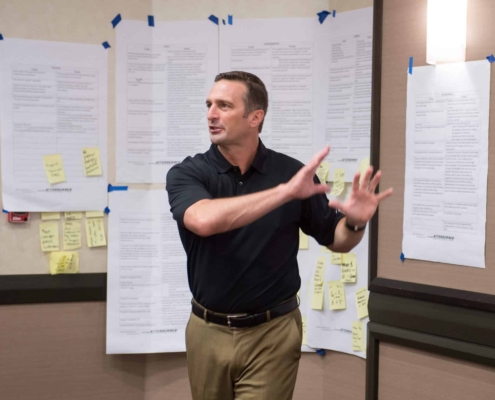 https://www.afterburner.com/wp-content/uploads/2024/10/Front-view-of-Afterburner-pilots-having-a-meeting.jpg
1250
2000
Abstrakt Marketing
/wp-content/uploads/2024/07/Afterburner-Logo-Resize-Fullcolor-300x93.png
Abstrakt Marketing2025-06-25 11:40:362025-06-30 15:56:09How Our Management Training Transforms Leaders
https://www.afterburner.com/wp-content/uploads/2024/10/Front-view-of-Afterburner-pilots-having-a-meeting.jpg
1250
2000
Abstrakt Marketing
/wp-content/uploads/2024/07/Afterburner-Logo-Resize-Fullcolor-300x93.png
Abstrakt Marketing2025-06-25 11:40:362025-06-30 15:56:09How Our Management Training Transforms Leaders
Outdated hierarchical, command and control management systems add complexity to complexity and do not provide today’s knowledge worker the autonomy and purpose needed to build learning and innovative cultures [1]. Moreover, today’s business leaders must realize that the most important work an organization will do is cognitive, not physical [2]. And the real threat to their organization is complexity, not competition. This means in order to survive and thrive in the next ten years, organizations must take a disciplined approach to collaboration, and develop effective leadership strategies to overcome group cognitive flaws and build leadership muscle memory through fractal leadership patterns to crush corporate complexity.
Before I introduce the simple ideas of Disciplined Collaboration and Fractal Leadership Patterns to add to your Agile arsenal, I want to offer some relevant background on cognitive work and complex systems, as well as build some “oh-s#*t!” urgency as to why your organization needs to become Agile now.
Cognitive Work in the Knowledge Economy
- Technology and information have moved us away from an industrial economy to a knowledge economy where cognitive work has replaced physical work.
- “The key component of a knowledge economy is a greater reliance on intellectual capabilities than on physical inputs or natural resources [3].”
Complex Systems. A simple definition of a complex system is it is diverse, connected, interdependent, and adaptive.
- Complex interactive systems do not follow simple linear processes.
- In complex systems there is too much information for any one person to process or any one expert to know, and the organizations that overcome complexity are those that tap into the greatest number of brains [4].
Tomorrow’s Complex Business Environment is Here
Companies listed in the S&P 500 today stand a one-in-four chance of remaining in the index in 2027. In the next 12 years 375 companies currently listed on the S&P 500, those that have a market cap greater than or equal to US $4.0 billion, will be replaced by companies that may not exist today. Worse than falling out of the S&P 500, companies that fail to adapt and innovate in the current turbulent business environment may join fallen giants such as Kodak, Nokia, Circuit City, Blockbuster, and Borders.
The good news about making predictions is: in a complex system, predicting the future is futile. However, this past month, December 2014, provided a harsh reminder that tectonic shifts in the market come without warning and disruptive technologies (mobile, social, media, cameras, sensors, the cloud, and emergent knowledge) are accelerating [5]. In December oil fell from $95 to below $60, hackers attacked Sony, Toyota introduced the hydrogen-powered car, and NASA printed on demand objects in space. If there is one takeaway from the events of this past month it is they validated the Law of Disruption—technology’s rate of change will remain exponential while we, the complex adaptive systems known as humans, will continue to change at a slower, incremental pace. That Agile thing everyone is talking about seems like a good idea now.
Deciding to be an Agile company is one thing. How your organization becomes agile is another. Here are two super weapons that will accelerate your agile journey.
Disciplined Collaboration Will Help You Determine the Best Leadership Strategies to Pursue
Complex problems require structured, collaborative thinking, and not just random talk.” – Liz Wiseman [6]
Sending a team of like-minded individuals with similar backgrounds and experience to sit in a room to collaborate without a creative planning and decision-making process is a prescription for group failure and does not foster leadership development. In his new book, Wiser: Getting Beyond Groupthink to Make Groups Smarter, Cass R. Sunstein identifies four causes of group failure [7]:
- Groups amplify the errors of its members
- Groups fall into herds and follow those who speak or act first
- Groups tend to get more extreme
- Members emphasize shared information at the expense of unshared information
To collaborate effectively, people need a simple, scalable, and repeatable process that mitigates the four causes of group failure.
Disciplined Collaboration is about how to harness cognitive diversity to create and innovate. An effective collaboration process should be dynamic, iterative, participatory, and, according to Jim Collins, consistent [8]. Some examples of Disciplined Collaboration include simple planning models, Delphi Technique, Red Teams, liberating structures, and proven debriefing techniques.
There are three basic elements to effective Disciplined Collaboration: (1) self-silencing leaders who also understand how to create psychological safety; (2) the identification of a list of potential solutions (planning) or events to be analyzed (debriefing); and (3) the selection of the preferred solution (planning) or root cause analysis that leads to actionable items (debriefing) [9].
Imagine if your company developed its strategy using the same planning process its software development or Sprint teams developed their Sprint forecast? Now imagine a company’s software developers and C-suite coming together to collaborate on designing a new product using the same simple, scalable, and repeatable Disciplined Collaboration planning process.
Fractal Leadership Patterns
Fractals repeat the same basic patterns that are self-similar across different scales
Applying Fractal Leadership Patterns to your business begins by establishing self-similar activities or events at all levels of an organization—ideally three levels. To combat complexity, these activities or events should follow the typical circular inspect and adapt the model of plan, communicate, execute, and assess. For example, the five events in Scrum (Plan – Standup – Sprint – Review – Retrospective) follow this circular pattern.
If your company uses Scrum for software development then you may be aware that how each event is conducted is up to the team or ScrumMaster—a real danger considering what you’ve just learned about group failures. Taking a step away from Scrum, take a look at your meetings. Are they structured? Do you feel that they are a waste of time? Do you commonly experience any of the four failures of groups? Is there any consistency on how your company plans, communicates, executes, and assesses its projects, programs, portfolios, and strategy?
The signature of mediocrity is not the unwillingness to change; the signature of mediocrity is chronic inconsistency. – Jim Collins
Fractal Leadership Patterns are interconnected, simple, scalable, and repeatable inspect and adapt events that contain the elements of Disciplined Collaboration and are designed to align an organization and build leaders. They work at all levels of an organization and accelerate performance, learning, collaboration, innovation, creativity, and adaptability. They are not intended to be proscriptive and can be modified as needed to fit the event and maturity level of the team.
Here is the cool thing about learning these Fractal Leadership Patterns: they teach leadership, at all levels. For example, a software developer who learns these patterns can lead a retrospective, a planning session, and a product development design thinking session. Whoa, what just happened? Only coaches, facilitators, or managers can lead these events, right? No. Welcome to the age of servant leadership where teams can be self-leading.
In conclusion, Disciplined Collaboration and Fractal Leadership Patterns are agility super weapons that overcome the failures of groups and combat complexity with simplicity. I look forward to your comments and questions.
Brian “Ponch” Rivera is a recovering Naval Aviator and current Afterburner, Inc. Enterprise Agile Coach and Executive Consultant who specializes in accelerating organizational agility with the simple tools found in the Flawless Execution℠ Model.
Afterburner, Flawless Execution, and STEALTH are registered with the U.S. Patent and Trademark Office and are owned by Afterburner, Inc.
[1] Daniel H. Pink. Drive: The Surprising Truth About What Motivates Us. (Riverhead, 2011)
[2] L. David Marquet. Turn the Ship Around!: A True Story of Turning Followers into Leaders. (Portfolio, 2013)
[3] The Knowledge Economy (Annu. Rev. Sociol. 2004.30:199-220. Downloaded from arjournals.annualreviews.org
[4] Steve Johnson. Emergence: The Connected Lives of Ants, Brains, Cities, and Software (New York: Scribner, 2001)
[5] Chunka Mui and Paul B. Carrol. The New Killer Apps: How Large Companies can Out-Innovate Start-Ups. (Cornerloft Press, 2013)
[6] Liz Wiseman. Rookie Smarts: Why Learning Beats Knowing in the New Game of Work. (New York, Harper Business, 2014)
[7] Cass R. Sunstein. Wiser: Getting Beyond Groupthink to Make Groups Smarter. (Harvard Business Review Press, 2014)
[8] Jim Collins and Morten T. Hansen. Great By Choice. ( New York, Harper Business. 2011)
[9] The ideas of self-silencing leaders, identifying a list of potential solutions and the selection of the preferred solutions are from the Cass Sunstein’s new book, Wiser: Getting Beyond Groupthink to Make Groups Smarter. I expanded the idea of self-silencing leaders to include psychological safety. I also applied his ideas to debriefing.
Share This Post
More Like This
 https://www.afterburner.com/wp-content/uploads/2024/10/Front-view-of-Afterburner-pilots-having-a-meeting.jpg
1250
2000
Abstrakt Marketing
/wp-content/uploads/2024/07/Afterburner-Logo-Resize-Fullcolor-300x93.png
Abstrakt Marketing2025-06-25 11:40:362025-06-30 15:56:09How Our Management Training Transforms Leaders
https://www.afterburner.com/wp-content/uploads/2024/10/Front-view-of-Afterburner-pilots-having-a-meeting.jpg
1250
2000
Abstrakt Marketing
/wp-content/uploads/2024/07/Afterburner-Logo-Resize-Fullcolor-300x93.png
Abstrakt Marketing2025-06-25 11:40:362025-06-30 15:56:09How Our Management Training Transforms Leaders
How FLEX Helps Leaders Combat the Cognitive Decline Epidemic
Business Culture, Leadership Development https://www.afterburner.com/wp-content/uploads/2025/06/Critical-thinking-Top-Gun-Experience.jpg
1365
2048
Ansley Anchors
/wp-content/uploads/2024/07/Afterburner-Logo-Resize-Fullcolor-300x93.png
Ansley Anchors2025-05-15 10:09:582025-06-30 15:56:10The Homer Simpson Effect on Critical Thinking
https://www.afterburner.com/wp-content/uploads/2025/06/Critical-thinking-Top-Gun-Experience.jpg
1365
2048
Ansley Anchors
/wp-content/uploads/2024/07/Afterburner-Logo-Resize-Fullcolor-300x93.png
Ansley Anchors2025-05-15 10:09:582025-06-30 15:56:10The Homer Simpson Effect on Critical Thinking https://www.afterburner.com/wp-content/uploads/2024/10/failure-scaled-1.jpg.jpg
1600
2560
Ansley Anchors
/wp-content/uploads/2024/07/Afterburner-Logo-Resize-Fullcolor-300x93.png
Ansley Anchors2025-02-20 11:29:502025-06-30 15:56:13Why Leadership Development Training Sucks — and the Data to Prove It
https://www.afterburner.com/wp-content/uploads/2024/10/failure-scaled-1.jpg.jpg
1600
2560
Ansley Anchors
/wp-content/uploads/2024/07/Afterburner-Logo-Resize-Fullcolor-300x93.png
Ansley Anchors2025-02-20 11:29:502025-06-30 15:56:13Why Leadership Development Training Sucks — and the Data to Prove It https://www.afterburner.com/wp-content/uploads/2024/09/Men-writing-in-notebooks-to-help-eliminate-task-saturation-1.png
511
1000
Nate Riggins
/wp-content/uploads/2024/07/Afterburner-Logo-Resize-Fullcolor-300x93.png
Nate Riggins2025-02-06 09:00:002025-06-30 15:56:133 Simple Ways to Eliminate Task Saturation
https://www.afterburner.com/wp-content/uploads/2024/09/Men-writing-in-notebooks-to-help-eliminate-task-saturation-1.png
511
1000
Nate Riggins
/wp-content/uploads/2024/07/Afterburner-Logo-Resize-Fullcolor-300x93.png
Nate Riggins2025-02-06 09:00:002025-06-30 15:56:133 Simple Ways to Eliminate Task Saturation https://www.afterburner.com/wp-content/uploads/2024/09/leadership-symposium-afterburner.png
1050
1832
Nate Riggins
/wp-content/uploads/2024/07/Afterburner-Logo-Resize-Fullcolor-300x93.png
Nate Riggins2024-01-26 15:53:082025-06-30 15:56:15Decoding the 3 Crucial Leadership Situations
https://www.afterburner.com/wp-content/uploads/2024/09/leadership-symposium-afterburner.png
1050
1832
Nate Riggins
/wp-content/uploads/2024/07/Afterburner-Logo-Resize-Fullcolor-300x93.png
Nate Riggins2024-01-26 15:53:082025-06-30 15:56:15Decoding the 3 Crucial Leadership Situations https://www.afterburner.com/wp-content/uploads/2024/09/thethreebiggest-1.jpeg
931
1400
Nate Riggins
/wp-content/uploads/2024/07/Afterburner-Logo-Resize-Fullcolor-300x93.png
Nate Riggins2024-01-03 15:04:522025-06-30 15:56:15The Three Biggest Obstacles to Building Trust as a Leader Today
https://www.afterburner.com/wp-content/uploads/2024/09/thethreebiggest-1.jpeg
931
1400
Nate Riggins
/wp-content/uploads/2024/07/Afterburner-Logo-Resize-Fullcolor-300x93.png
Nate Riggins2024-01-03 15:04:522025-06-30 15:56:15The Three Biggest Obstacles to Building Trust as a Leader Today https://www.afterburner.com/wp-content/uploads/2024/09/creating-a-strategy-1.jpeg
664
1000
Nate Riggins
/wp-content/uploads/2024/07/Afterburner-Logo-Resize-Fullcolor-300x93.png
Nate Riggins2024-01-03 08:00:192025-06-30 15:56:164 Questions You Have to Ask When Creating a Strategy
https://www.afterburner.com/wp-content/uploads/2024/09/creating-a-strategy-1.jpeg
664
1000
Nate Riggins
/wp-content/uploads/2024/07/Afterburner-Logo-Resize-Fullcolor-300x93.png
Nate Riggins2024-01-03 08:00:192025-06-30 15:56:164 Questions You Have to Ask When Creating a Strategy https://www.afterburner.com/wp-content/uploads/2024/09/CVMV_0008.jpg
1547
2100
Nate Riggins
/wp-content/uploads/2024/07/Afterburner-Logo-Resize-Fullcolor-300x93.png
Nate Riggins2022-11-10 15:37:382025-06-30 15:56:195 Leadership Skills to Get Your Revenue Engine Roaring in Q4
https://www.afterburner.com/wp-content/uploads/2024/09/CVMV_0008.jpg
1547
2100
Nate Riggins
/wp-content/uploads/2024/07/Afterburner-Logo-Resize-Fullcolor-300x93.png
Nate Riggins2022-11-10 15:37:382025-06-30 15:56:195 Leadership Skills to Get Your Revenue Engine Roaring in Q4About Us
Building Strong Teams Through the Guidance of Fighter Pilot Keynote Speakers.


